North City Gate and Water entrance Remains of Yangzhou City of the Song Dynasty
An ancient site was discovered in spring, 2003, when Yangzhou City was enlarging and refurbishing the west section of Caohe Avenue. Built entirely by large stone slabs, the site is located southeast of where the Yudai River and Caohe River converge. Yangzhou city archaeological team immediately conducted a test excavation. Thereafter they confirmed that the site was mainly consisted of remains once belonging to the north city gate and a water entrance of the Song Yangzhou City. In step with the dredging project of the Yudai River, an archaeological team that is constituted by scholars from the Institute of Archaeology, CASS, Nanjing Museum, and Yangzhou Bureau of Cultural Relics further excavated the site from March to May, 2004.
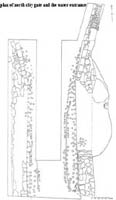
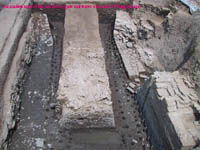
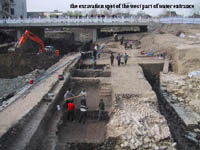 The excavation unearthed the east and west stone walls of the northern part of the water entrance, a slide on its east wall, the gateway, bank revetment, along with some wooden pillars, wooden plaques, and stone pillars that were originally placed in the riverbed. The excavation also found a large number of porcelain, iron utensils, bronze mirrors, coins, inscribed bricks, and fragmentary glass objects, all dated to the Tang through the Yuan dynasty.
The excavation unearthed the east and west stone walls of the northern part of the water entrance, a slide on its east wall, the gateway, bank revetment, along with some wooden pillars, wooden plaques, and stone pillars that were originally placed in the riverbed. The excavation also found a large number of porcelain, iron utensils, bronze mirrors, coins, inscribed bricks, and fragmentary glass objects, all dated to the Tang through the Yuan dynasty.
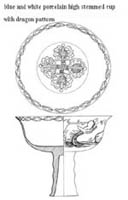
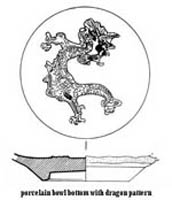

Understanding of the overall layout and structure of the water entrance by the north city gate of the Song Yangzhou city will be enhanced due to this excavation. For instance, it is confirmed by the excavation that remains made of rammed-earth in the site were originally Yangzhou city wall from the Five Dynasties to the Yuan Dynasty. The tunnel where the river once crossed the city wall is shown to have been furnished with stone wall as well as slides, and to have been equipped with wood piles along the riverbank. Some of the heaps may consist of the collapsed archway of the gateway. Once passing through the city wall, the water entrance used to possess bank revetment, and other apparatuses along the banks. Archaeological investigation so far indicates that the founding date of the water entrance cannot be earlier than the Five Dynasties. It was abandoned during the Yuan Dynasty. The eventual collapse of the gateway may have taken place in Ming times. Remains exposed so far by the excavation probably belong to the Southern Song Dynasty, as indicated by such phenomena as stratal relationship between this water entrance and the wall enclosure outside the north city gate, building techniques of the water entrance, size of the brick, technique of brick piling, and the use of plaster.
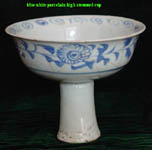

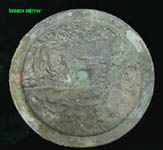
Discovery as such confirms some traditional textual records regarding the water entrance of the Song Yangzhou city. It also helps elucidate some architectural details in Yingzao Fashi, an architectural manual of the Song dynasty. The north city gate with its wall enclosure and this water entrance together constituted an important nexus controlling the waterway transportation north of the city in Song and Yuan times. This excavation will certainly exert great impact on future studies on the history and culture of the Song Yangzhou City. It will particularly provide important material evidence for reconstructing Yangzhou’s waterway transportation situation at Song and Yuan times.

